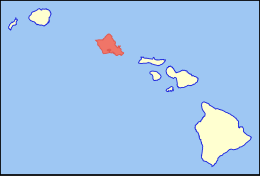
Back Oahu Afrikaans أواهو (هاواي) Arabic اواهو ARZ Oahu AST Oahu Azerbaijani اوآهو AZB Oahu BAR Ааху Byelorussian Оаху BE-X-OLD Оаху Bulgarian
Nickname: Gathering Place | |
|---|---|
 | |
 | |
| Geography | |
| Location | 21°30′N 158°00′W / 21.5°N 158.0°W |
| Area | 596.7 sq mi (1,545 km2) |
| Area rank | 3rd largest Hawaiian Island |
| Highest elevation | 4,025 ft (1226.8 m) |
| Highest point | Kaʻala |
| Administration | |
United States | |
| Symbols | |
| Flower | ʻilima |
| Color | Melemele (yellow) |
| Largest settlement | Honolulu |
| Demographics | |
| Population | 1,016,508 (2020) |
| Pop. density | 1,704/sq mi (657.9/km2) |
Oʻahu (pronounced /oˈʔɐhu/, /oʊˈɑːhuː/, sometimes written Oahu) is the third-largest and most populated island of the Hawaiian Islands and of the U.S. state of Hawaii.[1] The state capital, Honolulu, is on Oʻahu's southeast coast. The island of Oʻahu and the uninhabited Northwestern Hawaiian Islands[2] constitute the City and County of Honolulu. In 2021, Oʻahu had a population of 995,638,[3] up from 953,207 in 2010 (approximately 70% of the total 1,455,271 population of the Hawaiian Islands,[4] with approximately 81% of those living in or near the Honolulu urban area).
Oʻahu is 44 miles (71 km) long and 30 miles (48 km) across. Its shoreline is 227 miles (365 km) long. Including small associated islands such as Ford Island plus those in Kāneʻohe Bay and off the eastern (windward) coast, its area is 596.7 square miles (1,545.4 km2), making it the 20th-largest island in the United States.[5]
Well-known features of Oʻahu include Waikīkī, Pearl Harbor, Diamond Head, Hanauma Bay, Kāneʻohe Bay, Kailua Bay, and the North Shore.
- ^ Nichols, William D.; Shade, Patricia J.; Hunt, Charles D. (1996). Professional Paper (Report). doi:10.3133/pp1412a. hdl:2027/mdp.39015040694906.
- ^ "Northwest Hawaiian Islands". School of Ocean Science and Technology.
- ^ "US Census Bureau". Archived from the original on October 24, 2021. Retrieved December 9, 2021.
- ^ "US Census Bureau". census.gov.
- ^ "Table 5.08 – Land Area of Islands: 2000" (PDF). State of Hawaii. 2004. Archived from the original (PDF) on March 9, 2013. Retrieved July 23, 2007.